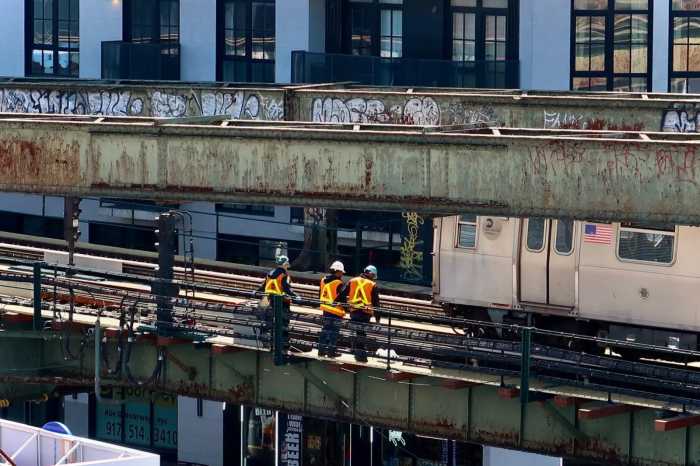Residents of Joralemon Street in Brooklyn Heights have long feared an
influx of vehicular and pedestrian traffic from the planned Brooklyn Bridge
Park waterfront project.
Over the last four years, those residents have been assured by the park’s
planners that traffic could be diverted from their narrow street either
by changing its direction, dead-ending it to all but emergency vehicles
or, most promisingly, by including Pier 6 in the plan, making Atlantic
Avenue the southern gateway to the park.
But now, with a new lead park planner, a new lead designer and a completely
reconceived plan for the park, Joralemon residents once again are left
with the prospect of their street — whose last couple of cobblestone
blocks lead down to Pier 5 — becoming a major park entrance.
The new plan calls for two high-rise apartment buildings near Atlantic
Avenue, one as tall as 30 stories, added to the residential conversion
of the existing 360 Furman St., a former Watchtower Society book-binding
facility. Critics worry that dense housing would reduce the amount of
open access to the park from Atlantic Avenue. Joralemon Street is one
block to the north.
Additionally, new plans call for a year-round soccer facility and parking
on or near Pier 5.
The response of one of the park’s designers to a question about Joralemon
Street’s status under the new plan did nothing to calm those concerns.
Asked at a Feb. 2 meeting hosted by the Brooklyn Bridge Park Conservancy
whether Joralemon Street might be used for vehicular access to Furman
Street and the pier, Matthew Urbanski, an associate of lead park designer
Michael Van Valkenburgh, said, “It might be, I’m not really
sure. I’m not that familiar with all the specific details of that.”
A roadway providing access to the new buildings, as well as the 500-unit
condominium conversion planned for 360 Furman St. stems from Furman Street
just above Pier 5, but does not appear to connect with Atlantic Avenue,
according to a scale model of the plans prepared by the designers.
Judy Stanton, executive director of the Brooklyn Heights Association,
said Urbanski’s response surprised many.
“We believed, until Matt made that off-handed remark, that the past
was the present,” she said referring to the 2000 park plan in which
Joralemon Street was restricted to through traffic by retractable bollards.
Wendy Leventer, president of the Brooklyn Bridge Park Development Corporation,
a subsidiary of the Empire State Development Corporation created to implement
the park plan, has referred all calls for comment on the park plan to
the parent agency. An ESDC spokesman did not return repeated telephone
messages and e-mailed questions regarding both Urbanski’s response
and the issue of Joralemon Street as a park entrance.
Peter Flemming, who, as a resident of 51 Joralemon St. would be a neighbor
of the new residential complexes, and who has been involved with the waterfront
planning for more than a decade, said both vehicular and pedestrian traffic
had been a contentious topic in the past.
“Joralemon Street [was planned to] actually become a dead end, with
bollards at the bottom of the hill with access only for police and fire
access. I myself thought it’s a little much, but I can’t be
against it,” he said.
Where the Joralemon Street residents were divided, Flemming said, was
by “people who were afraid there would be people walking down the
street. I was on the pro-walkers side.”
“As far as the sight-line goes, the taller and thinner the [planned
30-story] building, the better it is. It would be best if they desire
to have residential housing to make it as skinny as possible and I don’t
mind how high it gets,” he said.
But Sandy Balboza, president of the Atlantic Avenue Betterment Association,
said those same buildings are what would cause Joralemon Street to become
the main throughway for pedestrians and vehicles alike.
“This is what we’re saying — they’re privatizing the
entrance and the waterfront by building housing,” Balboza said, noting
that a grand “gateway” to the park along the four-lane Atlantic
Avenue could be lost in the mix.
“If you were going to the rec center, I think the feeling was you
could go down Joralemon Street,” said Balboza, referring to a Chelsea
Piers-like sports facility at Pier 5 in the original plans, which was
removed in the latest design. “You could get there from Court Street
and you could get there from turning off Atlantic Avenue.”
Though Donald Rattner, an urban planner who lives at 94 Joralemon St.,
called the street “a minor local roadway,” he said cutting it
off to through traffic “certainly made sense.” Nevertheless,
he suggested taking all parking off the piers and uplands to dissuade
driving altogether.
“The more access, the more parking, the more automobiles,” said
Rattner. “They really need to focus on ways to bring alternatives
to cars to this waterfront development.” “Obviously Atlantic
Avenue is amenable to serving as the main vehicular access.”
As to assurances that Joralemon Street would be kept traffic-free by the
old-guard of park planners — former BBPDC President James Moogan
and lead designer John Alschuler were replaced in the past year by Leventer
and Van Valkenburgh — Rattner said, “Promises were never etched
in stone. I wouldn’t take it for anything more than a verbal proposal.”
Balboza said that a 2002 workshop created an alternative design for Atlantic
Avenue as a “pedestrian friendly” entrance that included a traffic
circle, crosswalks and “a lot of green, to make it understood that
it was an entrance to a park, not that it was a speedway.”
“We believed that commitment was held,” said the BHA’s
Stanton. “It was assumed to be one of the givens. And when Matt Urbanski
said what he said, I thought I was going to flip.”
But Stanton said that she noticed upon viewing the model at Van Valkenburgh’s
office that the bollards were missing and a traffic circle and road entry
by way of Atlantic Avenue was also missing.
“Did Matt make a mistake? I sure hope so. If [what he said is] true,
why should anybody have ever believed any of the previous plans?”
Stanton wondered. “That was a flip answer that I hope doesn’t
reflect the treatment of Joralemon Street.”
She said that with the addition of apartment buildings near Pier 6, Joralemon
Street becomes a logical entryway to Furman Street for both pedestrians
and cars.
“I would be upset if I lived on Joralemon Street, and I think it
would be the wrong way to get there,” Stanton said. “If the
planners are changing their minds, I’ll be just as angry as the next
person.”























